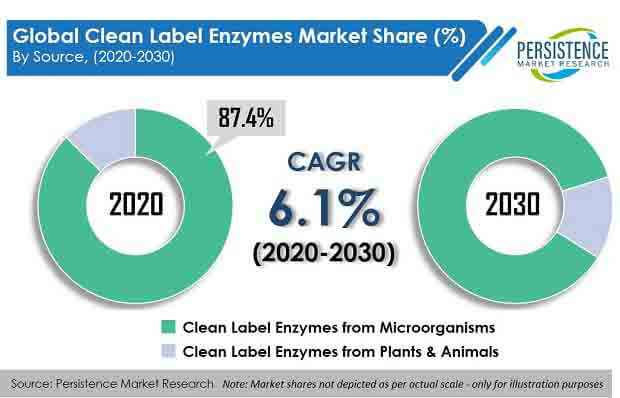The growth of the global clean label enzymes market is mainly due to their high usage in bakery ingredients, for increasing oxidation, reduced mixing time, improving machinability, and managing the speed of fermentation. Among all the types of clean label enzymes, the most prominent ones are carbohydrase and protease, which are offered by around 60% of the market players.
As per PMR analysis, the global clean label enzymes market is set to witness a healthy CAGR of 6% over the forecast period, to be valued at US$ 2.4 Bn by the year 2030.
To remain ‘ahead’ of your competitors, request for a sample here@ https://www.persistencemarketresearch.com/samples/29536
Key Takeaways from Clean Label Enzymes Market Study
- Growing popularity of enzymes in the food and beverage industry is favoring the growth of the global clean label enzymes market. Consumers are avoiding products containing ingredients that they are not familiar with. Azodicarbonamide is one such ingredient that food manufacturers are replacing with enzymes.
- The bakery and dairy industries are leading segments with a wide range of enzyme applications, as enzymes helps in increasing dough stability, volume of the dough, and shelf life of bakery products. Lactase enzymes are being widely used in the dairy industry to cater to lactose-intolerant consumers.
- Increasing inclination toward clean label products has been observed in the food sector, as consumers are choosing food products with ingredients that are natural with no chemicals, and those that can be easily recognized. Manufacturers are well aware of the fact that consumers of this generation do not want artificial ingredients.
- Enzymes enable food and beverage manufacturers attain a delicious new value stream and increase efficiency, profitability, and sustainability of processing lines. Being natural catalysts, enzymes are rapidly used as an alternative to chemical emulsifiers.
- The market is facing production and supply chain issues due to restrictions as a result of the COVID-19 pandemic. Production of only essential commodities is permitted in most countries. Growth of the market has thus been affected to some extent, with recovery expected in the fourth quarter of 2020.
“Leading manufacturers in the clean label enzymes market could gain more profits by launching application-specific products for the bakery and dairy industry, along with targeting lactose-intolerant customers for increased revenues,” says a PMR analyst

Get A Customized Scope To Match Your Need Ask An Expert – sales@persistencemarketresearch.com
Global Clean Label Enzymes Market: Competitive Landscape
Leading manufacturers in the clean label enzymes market space are launching new and innovative products to cater to increasing consumer demand for lactose- free products.
- In 2019, Chr. Hansen Holding A/S added a new enzyme to its diary enzyme line named CHY-MAX Supreme for cheese production.
- In March 2018, Koninklijke DSM N.V launched Maxilact, a lactase enzyme for increasing the production efficiency and capacity of dairy product manufactures to grow their business with lactose-free products
In addition, key players in the clean label enzymes landscape are focusing on partnerships with other manufacturers to increase the product offerings and supply of products in domestic as well as international markets.
- In December 2018, Kerry Group and Renaissance BioScience entered into a partnership for offering a new clean label product named Acryleast, to food and beverages manufactures. Acryleast is a non-GMO acrylamide reducing yeast enzyme.
More Insights on Global Clean Label Enzymes Market
Persistence Market Research presents detailed analysis of the global clean label enzymes market. The report includes historic (2015–2020) and forecast figures for the period 2020 and 2030. The report also provides detailed analysis of the global clean label enzymes market based on type (carbohydrase, lipase, protease, and others), source (microorganisms and plants & animals), and application (bakery, dairy, beverages, starch modification, protein modification, meat processing, and others), across seven key regions.
About us: Persistence Market Research
Contact us:
Persistence Market Research
Address – 305 Broadway, 7th Floor, New York City,
NY 10007 United States
U.S. Ph. – +1-646-568-7751
USA-Canada Toll-free – +1 800-961-0353
Sales – sales@persistencemarketresearch.com